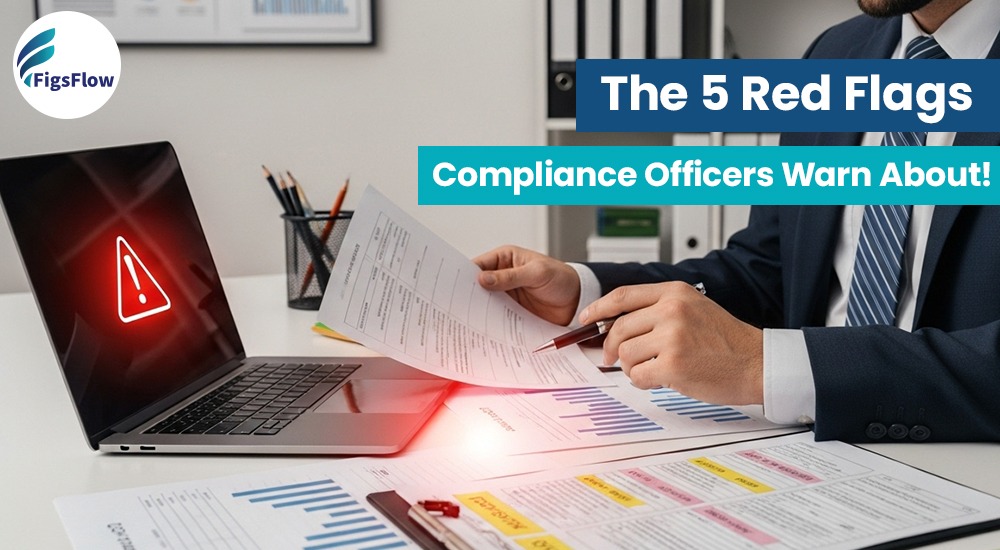HMRC’s AML fines have surged by a staggering 177% over the past four years. This sharp increase shows that UK regulators are cracking down harder than ever on money laundering. Making it vital for accountants to spot early AML red flags and address potential risks before they escalate.
That said, it’s not possible for accountants to dig into every single detail regarding the client they are seeking to work with. So, there’s always a risk of something slipping through and if it does, the consequences can be severe.
Does this mean accountants are at a dead end or is there a way to spot warning signs early and manage risk effectively?
Utilising their years of experience in onboarding clients and running AML checks, FigsFlow’s team has prepared this list of five aml red flags that accountants should keep an eye out for. .
We’ve also included a bonus tip at the end of this article to help you get automatic alerts when one of these red flag appears.
Sounds good? Let’s dive in.
What is AML Screening & Why Do AML Red Flags Matter?
AML screening is the process accountants use to verify client identities and assess money laundering risks before establishing a business relationship. It’s a legal requirement under the Money Laundering, Terrorist Financing and Transfer of Funds (Information on the Payer) Regulations 2017.
During AML screening, identifying AML red flags early is crucial. These red flags are warning signs that indicate a client may pose a higher risk of money laundering or financial crime. Spotting these indicators helps you decide whether to proceed with onboarding, conduct enhanced due diligence, or decline the engagement.
AML screening typically involves:
- Identity Verification: Confirming clients are who they claim to be through official documents.
- Risk Assessment: Evaluating money laundering risk based on business type, transactions, and location. This is where most AML red flags surface.
- Ongoing Monitoring: Continuously reviewing client activities for unusual behaviour.
- Enhanced Due Diligence: Applying additional scrutiny to high-risk clients, such as those from high-risk jurisdictions, Person with Significant Controls (PSCs), Politically Exposed Persons or with complex ownership structures.
By recognising AML red flags during the screening process, you can identify problematic clients early, avoid costly penalties, and protect your practice from being used for financial crime.
Now that you understand what AML screening entails, let’s explore the five critical red flags you should watch for during this process.
1. Reluctance to Provide Information

One of the most telling AML red flags in potential money laundering is when clients exhibit nervous behaviour or show unusual reluctance to comply with standard due diligence procedures. Such hesitancy is one of the most recognisable AML red flags accountants should be trained to identify from the outset. These behaviours can indicate an attempt to avoid scrutiny or conceal information that would otherwise be routine for legitimate businesses.
These behaviours can include:
- Hesitancy to provide identification document or beneficial ownership information
- Unusual nervousness about compliance procedures
- Requests for unnecessary secrecy or confidentiality
- Inconsistent personal information across documents
These red flags can be spotted through basic observation, common sense and an understanding of human psychology. So, it’s important to train your onboarding and front-line staff to recognise signs of hesitation, defensiveness or inconsistencies. When they do, prompt further questioning and carry out enhanced due diligence.
2. Suspicious Transaction Patterns & Cash Activities

Money launderers often leave distinct footprints in their transaction patterns, which can be detected through careful monitoring and analysis. Recognising these AML red flags in cash movements and client’s transactions helps accountants spot risk patterns long before they escalate.
Some of these patterns include:
- Large cash deposits or payments without clear business rationale – one of the most frequent AML red flags spotted by firms
- Rapid movement of funds between accounts
- Transactions inconsistent with known business activities
- Payment to and from parties with no apparent business relationships
- Deposits or payments that are just below reporting thresholds
These patterns can often be flagged by AML (Anti-Money laundering) software. These software detect any anomalies in client transactions and automatically trigger alerts. Some platforms even allow accountants to customise thresholds and criteria based on their risk appetite and client risk profile.
3. Complex Business Structures Without Clear Purpose

While complex business structures aren’t inherently suspicious, they can be used to obscure beneficial ownership and create AML red flags that facilitate money laundering. So, it’s important to remain cautious when clients establish multiple shell companies, use nominee directors, or create convoluted ownership arrangements that seem disproportionate to their actual business needs.
Here are a few things to watch out for:
- Complex ownership structures without a clear business purpose
- Multiple shell companies or nominee directors involved
- Business addresses that don’t match actual operations
- Involvement of high-risk jurisdictions without logical commercial reasons
These setups may be legitimate in some cases, such as for tax planning or international expansion, but they often signal deeper AML red flags worth investigating.
AML systems can help by flagging entities with links to high-risk jurisdictions or identifying patterns across related accounts. However, detecting suspicious ownership structure often requires manual review and investigative thinking. So, train your compliance and onboarding teams to spot inconsistencies, ask the right questions and escalate concerns.
4. Financial Inconsistencies & Unexplained Wealth

One of the most significant indicators of potential money laundering is when a client’s financial position doesn’t align with their known sources of income.
This includes:
- Lifestyle or spending habits that don’t match declared income
- VAT returns that don’t align with actual bank activity
- Unexplained wealth or asset acquisition without clear funding sources
- Payments from unexpected third parties
These inconsistencies often indicate that the funds may be coming from undisclosed or potentially illicit sources and can be detected through a combination of financial analysis and automated tools.
Many client onboarding platforms are equipped to flag mismatches between reported income and actual transaction volumes. These software can help surface the anomalies but actual human judgement is required especially when reviewing documents like VAT returns, bank statements and client disclosures.
5. Documentation & Source of Funds Issues

Poor quality, suspicious or incomplete documentation is another major AML red flag in identifying potential money laundering. These issues often surface during onboarding or periodic reviews and can indicate attempts to obscure identity, ownership or the origin of the funds.
Some of the common documentation-related red flags include:
- Poor quality or suspicious identification documents (e.g., altered, heavily photocopied or issued from high-risk jurisdictions)
- Frequent changes to company details without clear justification
- Missing or incomplete beneficial ownership information
- Documents from different sources that don’t align or contract each other
When documentation appears inconsistent or questionable, it’s essential to investigate further. Some AML software can help flag discrepancies in submitted data but detecting poor-quality or suspicious documents requires human judgement.
Introducing FigsFlow: Your All-in-One AML Solution
FigsFlow– includes a comprehensive AML module, making it one of the first (and arguably the best) complete onboarding platform that handles everything from proposals and engagement letters to AML screening and KYC checks in a single, integrated platform.
Here’s what you can do with FigsFlow:
- Generate professional proposals and regulatory compliant engagement letters in seconds
- Verify client identities digitally using industry standard technology that checks documents against comprehensive databases
- Screen clients automatically against global sanctions lists, PEP databases and adverse media
- Conduct automated risk assessments and Enhanced Due Diligence for high-risk clients
- Schedule automated AML checks at custom intervals with instant notifications about changes
- Maintain complete audit trails with automatic timestamps for every compliance action
FigsFlow delivers all of this within a single, accountant-centric workflow at the most affordable price in the market. Despite being purpose-built for how accounting practices operate, anyone on your team can use it confidently from day one.
So, what’s holding you back?
Try FigsFlow free for 30 days and experience the complete AML solution today.
Conclusion
It’s no doubt, AML compliance is difficult but as an accountant, you simply can’t avoid it. However, by knowing the most common AML red flags, you make the job easier for yourself and your onboarding team.
You can look for unusual client behaviour, suspicious transactions, complex ownership structures, financial inconsistencies, and poor-quality documentation. Spotting these early helps you reduce risk and stay ahead of regulatory fines.
And with platforms like FigsFlow, you can automate everything from initial proposals and engagement letters to AML checks and KYC. The choice is yours: either keep struggling with manual checks or get smarter with tools that do the heavy lifting for you.


